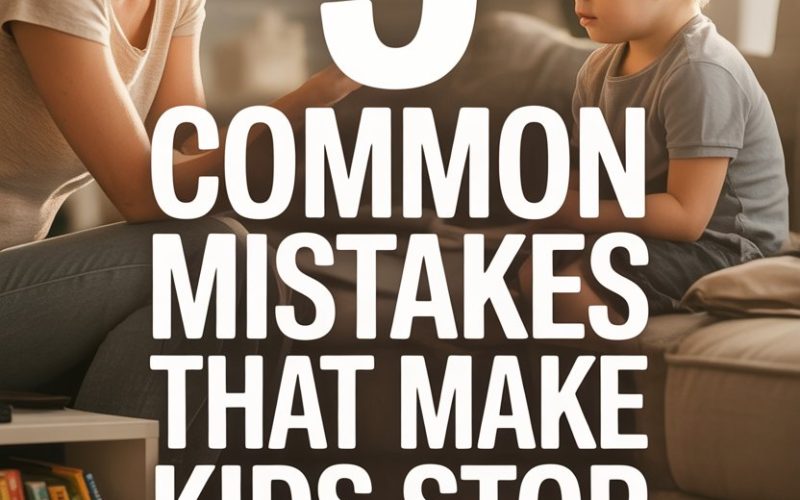Ever feel like you need a megaphone just to get your child to put on their shoes? Or maybe you’ve caught yourself wondering if your little one has developed selective hearing, especially right when it’s time to leave the playground? Welcome to the club.
Almost every parent has had those “why won’t you listen to me?” moments—sometimes so often that you start to suspect you’re narrating an invisible documentary.
If it feels like you’re talking but your kids aren’t tuning in, a few simple tweaks could help.
Here are the five most common slip-ups that shut down those tiny ears—and some practical fixes you can try tonight.
1. Talking Too Much (Monologues Don’t Work on Kids)
Picture this: You’re explaining the importance of cleaning their room, the science of germs, the history of socks, and also, by the way, could they please put on their shoes—all in one breath.
If you’re running out of steam before you get a reaction, you’re not alone.
Young children, especially under 10, aren’t wired to process a barrage of instructions.
According to child development experts, kids’ working memory is much smaller than adults’; stuffing it full of details is like trying to download the internet onto a flip phone.
The fix? Short and sweet wins the race. Try: “Shoes, please.” Or, “Time to wash hands.” If there’s a bigger message (the importance of hygiene, for example), save it for a calmer, less rushed moment.
And if you catch yourself launching into a TED Talk about why homework matters, pause and ask yourself: “Can I say this in five words or less?”
Occasionally, less is more—unless we’re talking about chocolate, then all bets are off.
2. Shouting Across the Room (Volume Isn’t the Problem)
Ever noticed how your child can’t seem to hear you when you’re asking them to brush their teeth from across the kitchen—but somehow, they can hear you unwrap a lolly three rooms away?
Shouting instructions from another part of the house rarely works. Youngsters are easily distracted, and ambient noise or screens don’t help.
Researchers from the Harvard Center on the Developing Child explain that kids respond better to face-to-face interactions because it engages their attention and cues.
Next time you need your child to listen, close the distance. Walk over, get down to their level (eye contact makes a world of difference), and use their name to get their attention.
A gentle touch on the shoulder can also help. This way, you’re not just a voice floating above the chaos; you’re a real human, right there, waiting for a response.
Bonus: It’s harder to ignore someone when they’re wearing bedroom slippers and staring you down at eye level.
3. Giving Orders Without Empathy (Robots Don’t Raise Kids)
“Put away your toys! Eat your peas! Stop hitting your brother!” Sound familiar? It’s all too easy to bark orders when you’re tired, running late, and everyone’s teetering on the edge of a meltdown.
The trouble with rapid-fire commands is that kids start tuning them out, especially if they sense frustration or impatience.
Parenting psychologist Dr. Laura Markham highlights that kids are more cooperative when they feel heard and understood—imagine that!
Try swapping commands for connection. Instead of “Put your shoes on—now!” try, “I see you’re having fun building your tower. When you’re ready, can you put your shoes on so we can go to the park together?”
This signals respect for their world and feelings. When kids feel respected, they’re far more likely to return the favour.
Will it work every time? Absolutely not. But you’ll be surprised at how often a little empathy opens ears.
4. Inconsistent Follow-Through (Empty Threats and Broken Promises)
“If you don’t tidy up, no telly tonight!” Sound like something you’ve said? Now, be honest: Did they still get to watch that show after a little negotiation or a sudden, mysterious bout of parental amnesia?
Nothing erodes a parent’s authority quite like empty threats and inconsistent consequences. When kids learn that what you say doesn’t always match what you do, they start to treat your words as background noise.
Consistency is your secret superpower. If you set a boundary or consequence, stick to it—without drama, lectures, or guilt.
The team at Raising Children Network recommends clear, fair, and predictable consequences. If you warn of ‘no dessert if you don’t eat your veggies,’ mean it (and brace yourself for protests louder than an out-of-tune recorder).
On the other hand, don’t forget about positive consistency: When you promise a Saturday pancake breakfast or an extra story at bedtime, follow through.
Kids who trust their parents to keep their word—good or bad—are far more likely to listen up next time.
5. Not Modelling Good Listening (Monkey See, Monkey Do)
Here’s the kicker: Many adults expect kids to listen on command, but don’t always return the favour.
Ever found yourself nodding along while scrolling your phone, only half-listening to your child explain the architectural merits of their latest Lego masterpiece?
Children are expert imitators. When they see adults listen with patience and interest, it signals that listening is valued.
A fascinating study from the University of Washington found that even babies learn social cues by watching adult faces during conversation.
Put your phone down, make eye contact, and show genuine interest—even if you’ve already heard the plot twist involving the lost sock six times. If your child feels heard, they’re far more likely to return the courtesy.
And yes, it can be mind-numbingly repetitive.
But at least you never have to fake surprise when you really do find that missing sock in the fridge.
Bringing Back the Conversation
Tuning out isn’t a permanent condition (even if it feels like it when you’re repeating “Brush your teeth!” for the five hundredth time). Most kids want to connect—they just need a little help sifting through the noise and distraction.
Shorten your instructions. Move closer. Lead with empathy. Stick to your word.
And, perhaps most importantly, show your kids what good listening looks like.
Every child, even the stubbornest of the bunch, has an off-switch for selective hearing—it just takes finding the right button.
And sometimes, that button is labelled “mum’s silly robot voice” or “dad’s wobbly penguin walk.” Use what works.
After all, the best conversations start when both sides feel heard—even if you’re both wearing your shoes on the wrong feet.





